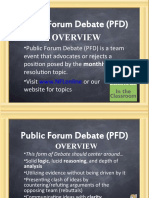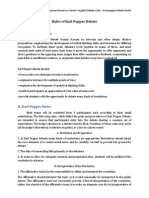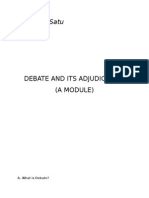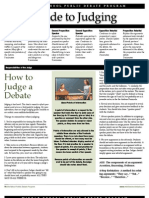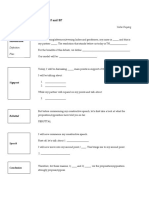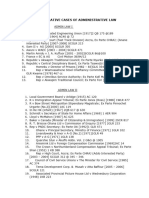Debate Topics and Debate Outline
Debate Topics and Debate Outline
Uploaded by
api-236273979Copyright:
Available Formats
Debate Topics and Debate Outline
Debate Topics and Debate Outline
Uploaded by
api-236273979Original Title
Copyright
Available Formats
Share this document
Did you find this document useful?
Is this content inappropriate?
Copyright:
Available Formats
Debate Topics and Debate Outline
Debate Topics and Debate Outline
Uploaded by
api-236273979Copyright:
Available Formats
Debate Topics and Debate Outline:
This assignment will have both an individual homework mark based on each members Briefing Notes and also a group mark for performance in the debate. Debates will be taking place during both classes during the week of October 7th October 11th. You may want to look up on the internet how to construct a briefing note but here are some guidelines for a good briefing note:
A well-prepared briefing note quickly and efficiently fills a person in on an issue. The most valuable BN is clear, concise, easy to read and assists a speaker in the best way possible to sound confident in their material. short: one to two pages, and always as short as possible concise: a short document isn't necessarily concise; concise means every word is used as efficiently as possible clear: keep it simple and to the point; always keep your reader firmly in mind and include only what matters to that reader reliable: the information in a briefing note must be accurate, sound and dependable; any missing information or questions about the information should be pointed out readable: use plain language and design your BN for maximum readability (use white space, subheadings, lists, font, and other means of making reading easier)
Before the debate begins, I will ask team members to hand in their briefing notes, labeled with each members name and role in the debate (example: first affirmative) For each debate topic, there should be at least one group that is positive (proposing an argument or resolution and making a case that it be true) and at least one group that is negative (in opposition to the resolution. In parliamentary debate, the resolution (proposed issue or argument), is preceded by the phrase Be It Resolved That or B.R.I.T.
Topic #1: B.R.I.T. The Corporation as a currently legally defined has allowed for more harm than good to our society and should be dismantled and redefined. Topic#2: B.R.I.T. Humans are cooperative, rather than competitive, by nature.
Each group will participate in a 14 minute debate in the following structure: First Affirmative First Negative Second Affirmative 2 minutes 2 minutes 2 minutes
Second Negative Break for Preparation Negative Summary/Rebuttal Affirmative Summary/Rebuttal First Affirmative:
2 minutes 2 minutes 2 minutes 2 minutes
1. Gives an introduction to the team and the names of members, and introduces the topic a. This introduction is intended to get the audience's attention and to introduce the subject. For example: "Ladies and gentlemen, imagine if you will that you are going for supper at a friend's home. You arrive at the home, but no one answers the door bell. The light is on and the door unlocked, so you go in. You are greeted by a horrifying sight: your friend has been murdered. After the police arrive they tell you that they suspect an escaped murderer. This murderer killed a prison guard when he escaped; the police tell you that had this individual been executed your friend might be alive today. Ecuador at present does not have capital punishment, but perhaps it should. The subject of the debate today is, "Be it resolved that capital punishment be reinstated in Canada." 2. Makes any relevant definitions relating to the issue at hand 3. Explain why the current policy/way of thinking/system is bad and needs change (proof) This can be done by demonstrating flaws in the current system or status quo. The needs for change are essentially the compelling reasons that will justify the plan. Typically the Affirmative will have time to present three to five needs for change. In a debate on reinstating capital punishment, the needs for change might be: a. Capital punishment would save money b. The existence of capital punishment deters others from murdering. 4. At least present the plan or present all of plan (policy debate) 5. Present reasons why First Negative: 1. Introduction of team members and introduction of the side of the argument the team is taking. It is recommended that this person also constructs the introduction in an interesting hook similar to the example given in the first affirmative. 2. If necessary, attack definitions 3. Clash with needs for change (proof)
4. If necessary, present counterplan (policy debate) 5. Clash with reasons/present counter reasons Second Affirmative: 1. Introduce only the second affirmative members and restate argument if necessary 2. Clash with points made by Negative and rebuild case for Affirmative 3. Present plan, if not already presented. Second Negative: 1. Introduce only the second negative members and restate argument if necessary 2. Continue attack on affirmative Negative and Affirmative Rebuttal: 1. 2. 3. 4. 5. 6. No new arguments can be made at this point Explain why your team should win and the other team should lose Remind the judge(s) of your arguments Tell the judge(s) why they should believe your arguments even after the other teams attack Explain why the judges should not listen to the other team Review critical evidence
Group Roles:
Most groups have been made up of 4 or 5 members and therefore positions will need to be shared and planned for. It is important that speaking time be more or less evenly shared between team members. For example, in a group of 5 the team roles could look like this: GROUP OF 5 First Affirmative: Group member #1 Group member #2 Second Affirmative: Group member #3 Group member #4 Rebuttal: 1 min 1 min (in a group of 4 this position would most likely be performed by one person only) 1 min 1 min
(if you like you can split the rebuttal into 2 people as well instead of something else) 2 min
Group member #5
You might also like
- Formulario Ds 160Document14 pagesFormulario Ds 160Starling Javier AbogadoNo ratings yet
- 美辩League GuideDocument34 pages美辩League Guide吴若雨No ratings yet
- Novice Handbook - Energy TopicDocument10 pagesNovice Handbook - Energy TopicAndrew Steven HeidtkeNo ratings yet
- SASDB Handbook Adjudicator ManualDocument11 pagesSASDB Handbook Adjudicator ManualMardiansyah Junior100% (1)
- 8 Debate FormatsDocument1 page8 Debate FormatsKarrenMaeObesoNo ratings yet
- APDA Guide To Parliamentary DebateDocument33 pagesAPDA Guide To Parliamentary DebateCarmen ZahariaNo ratings yet
- Karl Popper Score CardDocument6 pagesKarl Popper Score CardJFDanNo ratings yet
- Public Forum DebateDocument28 pagesPublic Forum DebatePeter RayNo ratings yet
- Stephens v. Hillsborough County Sheriff&apos S Office Et Al - Document No. 3Document7 pagesStephens v. Hillsborough County Sheriff&apos S Office Et Al - Document No. 3Justia.com100% (1)
- Student BookletDocument6 pagesStudent BookletMissCotonNo ratings yet
- An Introduction To British Parliamentary DebatingDocument6 pagesAn Introduction To British Parliamentary DebatingBilal RamzanNo ratings yet
- How To DebateDocument12 pagesHow To DebateCherry Mae PanongNo ratings yet
- Public Forum OverviewDocument3 pagesPublic Forum Overviewrhsdb8100% (1)
- Debate Contest Orientation 2023Document75 pagesDebate Contest Orientation 2023Choeun UCNo ratings yet
- An Introduction To British Parliamentary DebatingDocument5 pagesAn Introduction To British Parliamentary DebatingBryan Calumag RacuyaNo ratings yet
- Debate ManualDocument7 pagesDebate ManualIan LucasNo ratings yet
- Freely Austin, Argumentation and Debate (California: John Carrol University), p.15Document12 pagesFreely Austin, Argumentation and Debate (California: John Carrol University), p.15Dian FitriantiNo ratings yet
- Debate Speech Template: First Speaker, Affirmative TeamDocument5 pagesDebate Speech Template: First Speaker, Affirmative TeamMugiwara の NikenNo ratings yet
- Introduction To Argumentation and Debate: "With Words, We Govern Man." - Benjamin DisraeliDocument18 pagesIntroduction To Argumentation and Debate: "With Words, We Govern Man." - Benjamin DisraeliJohn Roger AquinoNo ratings yet
- SHS Rubric-9th.10th.-CCSS-W-1-9.20122-8 14 2016Document2 pagesSHS Rubric-9th.10th.-CCSS-W-1-9.20122-8 14 2016Korey BradleyNo ratings yet
- 11 Understanding Argumentation and DebateDocument32 pages11 Understanding Argumentation and Debateji eun leeNo ratings yet
- Rules of Karl Popper DebateDocument5 pagesRules of Karl Popper DebateDaniel Vodă100% (1)
- British Parliamentary DebateDocument4 pagesBritish Parliamentary DebateWilliam Mungai KariukiNo ratings yet
- Debating Theory Notes: WSDC Round FormatDocument12 pagesDebating Theory Notes: WSDC Round FormatagamNo ratings yet
- Module - Debate and Its AdjudicationDocument15 pagesModule - Debate and Its AdjudicationArif Husein LubisNo ratings yet
- A - Academic DebateDocument4 pagesA - Academic DebateGhazi Bahroz JumaaNo ratings yet
- Debate and Judge BriefingDocument114 pagesDebate and Judge Briefingdebate ddNo ratings yet
- Modified Karl Popper Debate FormatDocument6 pagesModified Karl Popper Debate FormatJFDanNo ratings yet
- Debate RubricDocument2 pagesDebate RubricJames Bo Kim100% (1)
- Matter Generation Workshop PDFDocument10 pagesMatter Generation Workshop PDFSebastián100% (1)
- Toulmin's Model AssignmentDocument3 pagesToulmin's Model AssignmentswathiNo ratings yet
- 11.1 - What Is An AbstractDocument17 pages11.1 - What Is An Abstractcol akhtarNo ratings yet
- Framework in Public ForumDocument3 pagesFramework in Public ForumjzofferNo ratings yet
- Framing in NegotiationDocument4 pagesFraming in Negotiationshreyakar100% (1)
- Debate Lesson PlanDocument3 pagesDebate Lesson Planapi-280689729No ratings yet
- Stasis Theory in Academic Writing - Student Slides 3Document11 pagesStasis Theory in Academic Writing - Student Slides 3api-490608937No ratings yet
- Debate Format ExplanationDocument12 pagesDebate Format Explanationlisha poojaryNo ratings yet
- Motion Analysis WSDCDocument3 pagesMotion Analysis WSDCAfiaNo ratings yet
- The Reframing MatrixDocument3 pagesThe Reframing MatrixMugdha Amin100% (1)
- Debate Template - CNDF and BPDocument1 pageDebate Template - CNDF and BPMatthew PiNo ratings yet
- Four Corners ActivityDocument2 pagesFour Corners Activityapi-134134588No ratings yet
- Report On Academic DebateDocument8 pagesReport On Academic DebateMohamad NazmNo ratings yet
- How To Properly Adjudicate DebatesDocument4 pagesHow To Properly Adjudicate DebatesKevin Ken Sison GancheroNo ratings yet
- 11U Poetry Analysis Four LevelsDocument1 page11U Poetry Analysis Four Levelsseiranhoj0901100% (1)
- Debate RulesDocument13 pagesDebate RulesPhaisal GuladeeNo ratings yet
- Paragraph Writing: A Paragraph Deals With A Single Controlling IdeaDocument17 pagesParagraph Writing: A Paragraph Deals With A Single Controlling Ideaduppal35No ratings yet
- Narrative Speech PresentationDocument2 pagesNarrative Speech PresentationNevie Nurjayanti100% (1)
- Introduction To Debate, HandoutDocument1 pageIntroduction To Debate, HandoutRj BallNo ratings yet
- Lesson 2 Critical ThinkingDocument4 pagesLesson 2 Critical ThinkingBeatrice De GuzmanNo ratings yet
- Canberra - Writing A Literature ReviewDocument3 pagesCanberra - Writing A Literature ReviewAndreaNo ratings yet
- Debate Chairperson's FlowchartDocument1 pageDebate Chairperson's FlowchartChiew N Pang100% (1)
- Five Steps For Preparing A Debate With A ClassDocument2 pagesFive Steps For Preparing A Debate With A ClassTeresa UriarteNo ratings yet
- Policy Debate Style GuideDocument11 pagesPolicy Debate Style GuideFreeDebateLeagueNo ratings yet
- Contention - The Waves Debate: Brochure and Rule BookDocument20 pagesContention - The Waves Debate: Brochure and Rule Bookashwinkrishnan181995No ratings yet
- Introduction To Rhetoric - HandoutDocument2 pagesIntroduction To Rhetoric - Handoutapi-285788980No ratings yet
- MetaphorsDocument4 pagesMetaphorsmisschen100% (1)
- What Is A Counter-Argument?Document8 pagesWhat Is A Counter-Argument?Xiao NaNo ratings yet
- Impromptu SpeechDocument11 pagesImpromptu SpeechHavie Joy SiguaNo ratings yet
- Pathos, Logos and EthosDocument2 pagesPathos, Logos and EthosZnow BearNo ratings yet
- BP Style IntroductionDocument6 pagesBP Style IntroductionSAFINA ALMIRA SUSENONo ratings yet
- An Introduction To British Parliamentary DebatingDocument9 pagesAn Introduction To British Parliamentary DebatingIzzat Azmeer AhmadNo ratings yet
- Debate ManualDocument17 pagesDebate ManualFernando SabinoNo ratings yet
- Debate Topics and Debate OutlineDocument3 pagesDebate Topics and Debate Outlineapi-236273979No ratings yet
- Recommended Steps For Partnership AgreementDocument2 pagesRecommended Steps For Partnership Agreementapi-236273979No ratings yet
- Week3class2 - Right Vs LeftDocument17 pagesWeek3class2 - Right Vs Leftapi-236273979No ratings yet
- Week3 cl3 ch2 ReviewDocument11 pagesWeek3 cl3 ch2 Reviewapi-236273979No ratings yet
- Class 3 Tuckmans StagesDocument13 pagesClass 3 Tuckmans Stagesapi-236273979No ratings yet
- Section 504 of The Rehabilitation Act of 1973: Grand Canyon University EAD-505Document13 pagesSection 504 of The Rehabilitation Act of 1973: Grand Canyon University EAD-505api-309737337No ratings yet
- ADMINISTRATIVE LAW OutlineDocument7 pagesADMINISTRATIVE LAW OutlineRabi RoescaNo ratings yet
- I 7913 enDocument30 pagesI 7913 enHassan AL-HillaliNo ratings yet
- General Assemblies Where The Administration Manual Is Discussed and ElaboratedDocument2 pagesGeneral Assemblies Where The Administration Manual Is Discussed and ElaboratedAlfonso AmpongNo ratings yet
- A Search For Identity - John Henrik ClarkeDocument7 pagesA Search For Identity - John Henrik ClarkeChinyerim100% (1)
- Final SADC-EU EPA Text and AnnexesDocument1,394 pagesFinal SADC-EU EPA Text and Annexesbi2458No ratings yet
- Agenda IACCRVS 3rd Regular Meeting - La UnionDocument1 pageAgenda IACCRVS 3rd Regular Meeting - La UnionMarijoe Kate HufalarNo ratings yet
- Kami Export - Areyan Rastawan - MLKMXDBQ Text PacketDocument10 pagesKami Export - Areyan Rastawan - MLKMXDBQ Text PacketAsvag OndaNo ratings yet
- Monetary BoardDocument32 pagesMonetary Boardnikki nozawa100% (1)
- 11 5 14Document24 pages11 5 14greercitizenNo ratings yet
- Black Power Movement Essay Grade 12Document4 pagesBlack Power Movement Essay Grade 12magubaneayabonga2007No ratings yet
- Otak International: Oil Storage Volume 2052 Ltr. Sludge Trap Volume 4000 Ltr. Total Capacity Volume 8553 LTRDocument1 pageOtak International: Oil Storage Volume 2052 Ltr. Sludge Trap Volume 4000 Ltr. Total Capacity Volume 8553 LTRnaveenNo ratings yet
- Appointment Confirmation: Important Instructions To Nonimmigrant Visa ApplicantsDocument3 pagesAppointment Confirmation: Important Instructions To Nonimmigrant Visa ApplicantsDimitri D'Lost SandtoesNo ratings yet
- Global CitizenshipDocument2 pagesGlobal CitizenshipRu RuNo ratings yet
- Cases On Administrative LawDocument2 pagesCases On Administrative Lawakwasiamoh501No ratings yet
- PTET-2022 Admit CardDocument2 pagesPTET-2022 Admit CardSimranpreet SudanNo ratings yet
- Josh Brooman Italy & Mussolini Italy 1900-45Document36 pagesJosh Brooman Italy & Mussolini Italy 1900-45Pedro Bento100% (2)
- Language and SocietyDocument167 pagesLanguage and SocietyKaneNo ratings yet
- BaghusDocument12 pagesBaghusAmir 'IzzatNo ratings yet
- Conflicts Between ITLOS and ICJDocument13 pagesConflicts Between ITLOS and ICJManu Lemente100% (1)
- A Manual of American IdeasDocument316 pagesA Manual of American IdeasHoward HughesNo ratings yet
- Open Letter To Our Community Regarding MarriageDocument2 pagesOpen Letter To Our Community Regarding MarriageNeenNo ratings yet
- Your Guide To Music and The SDGsDocument55 pagesYour Guide To Music and The SDGsVicenta FusterNo ratings yet
- The Tamil Nadu Urban Local Bodies (Installation of Closed Circuit Television Units in Public Buildings) Rules 2012Document7 pagesThe Tamil Nadu Urban Local Bodies (Installation of Closed Circuit Television Units in Public Buildings) Rules 2012kayalonthewebNo ratings yet
- Tiktok QuestionnaireDocument4 pagesTiktok QuestionnaireRahman OluwaseyiNo ratings yet
- National Labor Relations Board v. Southwestern Colorado Contractors Association and Its Members, 447 F.2d 968, 10th Cir. (1971)Document3 pagesNational Labor Relations Board v. Southwestern Colorado Contractors Association and Its Members, 447 F.2d 968, 10th Cir. (1971)Scribd Government DocsNo ratings yet
- Implanting Palestinian AwnaDocument17 pagesImplanting Palestinian Awna7o413nig6No ratings yet
- Walta ActDocument15 pagesWalta ActRaghu RamNo ratings yet







